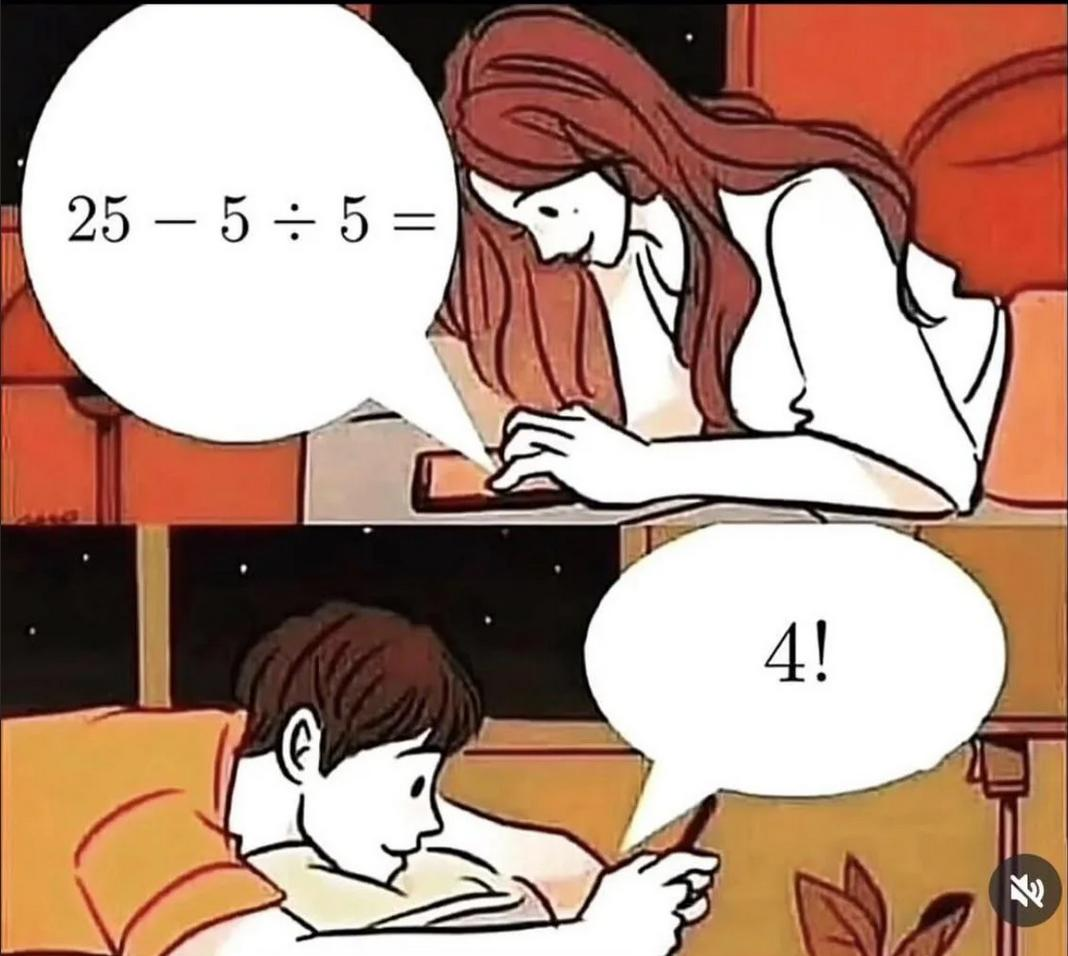I understand why this is wrong (order of operations dictates the division happens first, so it's really 25 - 1 = 24), but why is it funny? I don't mean "This isn't funny," I think I'm just missing the joke.
4! Is meant to be 4 factorial. 4! = 4 x 3 x 2 x 1 = 24
Aha! Got it, thank you so much.
And here I was thinking I was still decent at math. I got bamboozled...
Or if you don’t know order of operations, then you probably also don’t know factorials, so 20 / 5 = 4
The fuck is a "factorial"? They didn't teach me that one in high school math and I couldn't afford college.
Im sorry your highschool curriculum failed to teach you. I learned factorals in jr highschool
Factorial means n! = (n)(n-1)(n-2)... etc. down to 1, where n is a positive integer. It's used to calculate the different number of configurations of a set of elements, mainly in combinatorics.
Like if you have four different objects and you want to know how many different configurations you can order them in, you have four choices for the first object, then three for the second, then two for the third, then one for the final slot. So the answer is 4 x 3 x 2 x 1 = 24 = 4!.
4! Is a factorial which means it's 4 x 3 x 2 x 1 = 24
Totally missed that. Thank you.
4 factorial
The exclamation point denotes the factorial function. 4! = 4 ⋅ 3 ⋅ 2 ⋅ 1
I see no one has explained yet, so I'll give it a shot. He is excited about math, and that needs to be encouraged.
The exclamation point makes it right. The formula, when worked with proper order of operations, equals 24, which is equal to 4 factorial (4!) 1 * 2 * 3 * 4=24

Best math meme so far.
ASCII hack failure of language. Even in mathematics, ! has multiple meanings like with Boolean NOT. We need a science, math, and language reformation to remove non intuitive narcissistic names, and implied contextual meanings.
You might find Lojban interesting if you are not already aware. (I haven't tried to learn it myself, I just know it exists)
I believe you mean, "nice pun!"
I've never seen ! used for boolean NOT in maths, just ¬. I think ! is something programming languages went for because it's easier to type. That said, screw (a, b). Is that a (coordinate) pair, an interval, an inner product, some secret fourth thing? Who knows!
Comment section full of people looking for an opportunity to argue
No it isn't
You got the wrong symbol in the headline, it should be >3
Ok this is funny
This is quite possibly the best maths joke I've ever seen.
[edit] I guess it still can't beat the 'be rational' / 'get real' one.
Thank God this meme is muted
Clever! lol
for those that didn't get it: clever factorial = brilliant
I’m only going to say this once but if I’m doing a sum and you want me to do it in a specific order, use brackets. That’s what brackets are for. Don’t expect me to do things in a predetermined order because I literally can’t be bothered and I will never care enough to do that. I’m already doing a sum so don’t push it, okay bud
But that's a bit like saying "If you're going to talk to me, put the adjectives before the nouns," even in Spanish where they come after. Mathematical notation is a language and it has a syntax. Sure, you can decide to ignore that syntax, or insist that people modify their use of it for you, but it's not really a reasonable expectation.
Jokes and tricks that hinge on unclear communication (eg: not using parenthesis or other notation to make intent clear), and then are smug when people are tricked, remind me of the old xkcd https://xkcd.com/169/
I just saw some jokes about factorials so at least I got this one, heh.
Math Memes
Memes related to mathematics.
Rules:
1: Memes must be related to mathematics in some way.
2: No bigotry of any kind.
